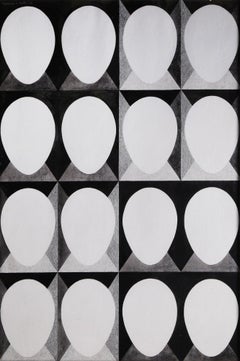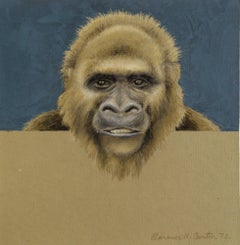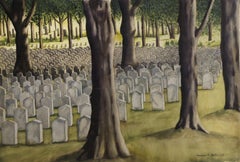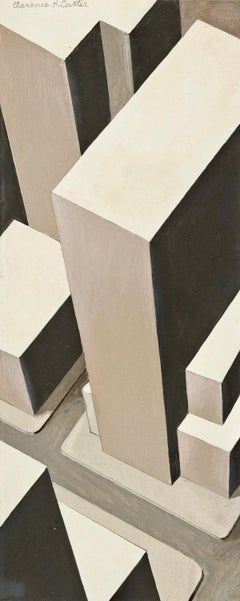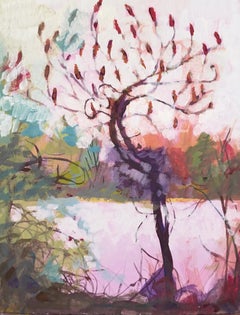Clarence Holbrook Carter Drawings and Watercolor Paintings
American, 1904-2000
Clarence Holbrook Carter achieved a level of national artistic success that was nearly unprecedented among Cleveland School artists of his day, with representation by major New York dealers, scores of awards and solo exhibits, and streams of praise flowing from pens of the top art critics. Over the course of his 60+ year career Carter evolved from an exceptionally fine American Scene painter capable of evoking deep reservoirs of mood, into an abstractionist with a strongly surrealist bent.
While his two bodies of work seem at first to be worlds apart, owing to their different formal vocabularies, they, in fact, explore virtually the same subject: the nexus between life and death and the transition from earth to spirit. The early work finds its expressive power through specific people, events, and landscapes—most of which are drawn from his experiences growing up in the river town of Portsmouth, Ohio—while the later work from the 1960s on evokes potent states of being through pure flat shape, color and form that read as universals. As his primary form he adopted the ovoid or egg shape, endowing it with varying degrees of transparency. Alone or in multiples, the egg moves through Carter’s landscapes and architectural settings like a sentient spirit on a restless quest.
Born and raised in southern Ohio along the banks of the mercurial Ohio River and its treacherous floods, Carter developed a love of drawing as a child, and was encouraged by both his parents. He was self-directed, found inspiration all around him, and was strongly encouraged by the fact that his teenage work consistently captured art prizes in county and state fairs. Carter studied at the Cleveland School of Art from 1923-27, where he trained under painters Henry Keller, Frank Wilcox and Paul Travis.
Returning to Cleveland in 1929, Carter had his first solo show, and through Milliken taught studio classes at the Cleveland Museum of Art from 1930-37. In 1938, he moved to Pittsburgh to teach at the Carnegie Institute of Technology until 1944. Carter’s American Scene paintings of the ’30s and ’40s, which launched his artistic star, are the works for which the artist remains best known.
During and immediately after World War II, Clarence Carter realized his attraction to bold pattern, dramatic perspective and eye-catching hard-edged design was a poor fit with the prevailing style of Abstract Expressionism. Fortunately, these same hallmarks of his style were prized within the realm of commercial art.
Around 1964 Carter acknowledged a need to break from the confines of representational painting. Once Carter had found a potent symbol in the egg, he used it to create an astounding body of imagery for the rest of his life. Among the most ambitious of all his later paintings were his Transections, a theological term meaning to cross, specifically between life and death.(Biography provided by WOLFS)
to
1
7
6
5
1
1
2
4
1
Overall Height
to
Overall Width
to
5
1
1
1
1
1
1
1
1
1
1
1
1
1
1
1
7
1
1
1
2
1
1
93
758
412
288
228
4
4
2
1
1
Artist: Clarence Holbrook Carter
Volcano and Arch, Taormina, Sicily, Italy, Mid Century Cleveland School Artist
By Clarence Holbrook Carter
Located in Beachwood, OH
Clarence Holbrook Carter (American, 1904-2000)
Volcano and Arch, Taormina, 1961
Watercolor on scintilla paper
Signed and dated upper right
11 x 11 inches
"My last year in art schoo...
Category
1960s American Modern Clarence Holbrook Carter Drawings and Watercolor Paintings
Materials
Watercolor
Study for Worlds Beyond - Surrealist graphite drawing, Ohio artist
By Clarence Holbrook Carter
Located in Beachwood, OH
Clarence Holbrook Carter (American, 1904-2000)
Study for Worlds Beyond, 1980
Graphite, collage and white heightening on illustration board
Signed and dated lower right
10.75 x 4.5 in...
Category
1980s American Modern Clarence Holbrook Carter Drawings and Watercolor Paintings
Materials
Graphite
"People" - Mid-Century Ovoid Geometrical Abstract Black & White Drawing
By Clarence Holbrook Carter
Located in Beachwood, OH
Clarence Holbrook Carter (American, 1904-2000)
People, 1964
Ink and crayon on paper
Signed and dated upper right
36.5 x 24 inches
Clarence Holbrook Carter achieved a level of nation...
Category
1960s American Modern Clarence Holbrook Carter Drawings and Watercolor Paintings
Materials
Crayon, Ink
Pappy (Study for Over and Above: Gorilla), Mid-Century Figurative Drawing
By Clarence Holbrook Carter
Located in Beachwood, OH
Clarence Holbrook Carter (American, 1904-2000)
Pappy (Study for Over and Above: Gorilla), c. 1973
Colored pencil on paper
Signed and dated lower left
7 x 7 inches
20.75 x 19 inches, framed
Clarence Holbrook Carter achieved a level of national artistic success that was nearly unprecedented among Cleveland School artists of his day, with representation by major New York dealers...
Category
1970s American Modern Clarence Holbrook Carter Drawings and Watercolor Paintings
Materials
Color Pencil
Confederate Soldiers' Cemetery, Camp Chase, Columbus, Ohio Watercolor
By Clarence Holbrook Carter
Located in Beachwood, OH
Clarence Holbrook Carter (American, 1904-2000)
Confederate Soldiers' Cemetery, Camp Chase, Columbus, Ohio, 1929
Watercolor on paper
Signed and dated lowe...
Category
1920s American Modern Clarence Holbrook Carter Drawings and Watercolor Paintings
Materials
Watercolor
Abstract Cityscape Mid 20th Century Modern Cubist Work on Paper Drawing Ariel
By Clarence Holbrook Carter
Located in New York, NY
Abstract Cityscape Mid 20th Century Modern Cubist Work on Paper Drawing Ariel
11 x 4 1/2 inches. Framed by Heydenryk.
Provenance: Gary Snyder Fine Art
B...
Category
1950s Abstract Clarence Holbrook Carter Drawings and Watercolor Paintings
Materials
Paper, Gouache
Chrysanthemums and Tiger Lilies
By Clarence Holbrook Carter
Located in Fairlawn, OH
Chrysanthemums and Tiger Lilies
Signed and dated lower left (twice), see photo
Watercolor on paper, 1935
A symbol of the sun, the Japanese consider the or...
Category
1930s Realist Clarence Holbrook Carter Drawings and Watercolor Paintings
Materials
Watercolor
Related Items
'Sunset Landscape', Hamburg, Rivne, Volhynia, Rivne Museum
Located in Santa Cruz, CA
Signed lower right, 'G. Kosmiadi' for Georg Kosmiadi (Ukranian-German, 1886-1967) and dated, '66'; additionally signed verso, 'Georg Kosmiadi', inscribed with serial number and dated, '20/9/66'.
Georg Kosmiadi was a resident of Rivne before moving to Hamburg in 1940 where he worked as an art teacher. Kosmiadi exhibited at the Rivne Regional Museum and a regional art...
Category
1960s Abstract Impressionist Clarence Holbrook Carter Drawings and Watercolor Paintings
Materials
Paper, Gouache
Sumac, colorful Abstract Impressionist landscape gouache
By Sandy Litchfield
Located in New York, NY
Sandy Litchfield found peace and inspiration in regular solitary walks through nature throughout the pandemic. Her most recent body of work diaristically documents her constitutional...
Category
2010s Abstract Impressionist Clarence Holbrook Carter Drawings and Watercolor Paintings
Materials
Paper, Gouache
African American Woman artist Mailou Jones Cezannian Cote d'Azur cubist village
Located in Norwich, GB
If you are interested in African American Art and in Women in the Arts, I will certainly not need to introduce Lois Mailou Jones (1905-1988). Often associated with the Harlem Renaiss...
Category
Mid-19th Century American Modern Clarence Holbrook Carter Drawings and Watercolor Paintings
Materials
Watercolor, Gouache, Handmade Paper
H 29.93 in W 25.79 in D 1.19 in
Golf Bags, Caddy with Golf Bag on His Back
By Frederick Conway
Located in Missouri, MO
Framed Size: approx 17 3/4 x 20 3/4 inches
Fred Conway (1900-1973)
"Golf Bags, Caddy with Golf Bag on His Back"
Pen/Ink/Watercolor on Paper
Site Size: approx. 10 x 13 inches
Framed Size: approx. 17 3/4 x 20 3/4 inches
A member of the faculty of the Washington University Art School from 1929 to 1970, Frederick Conway...
Category
1960s American Modern Clarence Holbrook Carter Drawings and Watercolor Paintings
Materials
Paper, Ink, Watercolor, Pen
The Sketch Class, Figurative Study Line Drawing
By David Rosen (b.1912)
Located in Soquel, CA
Expressive line drawing figure study featuring a group of figures in a classroom by David Rosen (Canadian, 1912-2004). Unsigned, but was acquire...
Category
Late 20th Century American Modern Clarence Holbrook Carter Drawings and Watercolor Paintings
Materials
Paper, Pen, Watercolor
H 12 in W 8 in D 0.25 in
Canal in Venice, English Watercolour
Located in Harkstead, GB
A very atmospheric watercolour capturing the light and shimmer of a Venetian canal. One of two views of Venice by the artist that I am offering - please see my other listing.
Dennis Page (born 1926)
Venice Balcony
Signed
Watercolour
8½ x 12 inches including the frame
16¾ x 21 inches with the frame
Painter, mainly in watercolour who was born in Hampstead, London. He studied art at Harrow and the Central School of Arts & Crafts, where his tutors included Mervyn Peake...
Category
Late 20th Century Modern Clarence Holbrook Carter Drawings and Watercolor Paintings
Materials
Paper, Watercolor
Pinto, 1930s Modernist Line Figure Drawing, Native American on Horse, Black Ink
By Hilaire Hiler
Located in Denver, CO
Original 1933 drawing, "Pinto" by New Mexico modernist, Hilaire Hiler (1898-1966), black and white line drawing of a Native American Indian figure wearing a feather bonnet headdress on horseback. Ink on vellum, signed lower right. Custom framing is available.
Expedited and international shipping is available - please contact us for a quote.
About the Artist:
Hilaire Hiler was born in St. Paul, Minnesota, and was raised in Providence, Rhode Island. Hiler took art classes as a child at the Rhode Island School of Design.
When he was older, Hiler studied at the Pennsylvania Academy of the Fine Arts, the Pennsylvania School of Industrial Art, Wharton School of Finance and Commerce, and William Server’s studio. He also studied at the University of Pennsylvania, the University of Denver, Golden State University, and National College in Ontario, Canada. He continued on to France, studying at the University of Paris in 1919. Hiler lived in Paris from 1919-1934, supporting himself as a jazz musician and a piano player for The Jockey Club.
Hiler moved back to America in 1934, settling in San Francisco. He was commissioned by the Works Progress Administration to paint murals in the Aquatic Park...
Category
1930s American Modern Clarence Holbrook Carter Drawings and Watercolor Paintings
Materials
Ink
H 9.25 in W 7 in D 0.2 in
Llangorse Lake, Brecon Beacons, Wales, circa 1964. Welsh Landscape. Abstract.
By Roger Cecil
Located in Sutton Poyntz, Dorset
Roger Cecil.
Welsh ( b.1942 - d.2015 ).
Llangorse, Brecon Beacons
Watercolor and pastel on paper. Signed.
Image size 19.5 inches x 29.5 inches ( 49.5cm x 75cm ).
Frame size 24.6 inches x 34.6 inches ( 62.5cm x 88cm ).
Available for sale; this original painting is by the Welsh artist Roger Cecil and dates from around 1964.
The watercolor and pastel work is presented and supplied in a sympathetic contemporary frame (our stock frame, which is shown in these photographs), mounted using conservation materials and behind glass. The original backboard has been reused but the artwork has been isolated from it using conservation barrier materials.
This vintage artwork is in good condition, commensurate with its age. Previous cockling (rippling) of the paper has been eliminated by stretching and the use of a new mounting. Previous foxing and age marks have been mechanically removed and the coarse fiber of the paper has been made good in these areas. The painting is now ready to hang and display.
The watercolor is signed lower left.
Provenance: Previously with the Howard Roberts Gallery, Imperial Buildings, 69/74 St Mary Street, Cardiff.
Roger Cecil was a reclusive painter, draughtsman and teacher who was born in Abertillery, Monmouthshire in 1942. He lived and worked in Wales for the last four decades of his life, much of it in the house where he was born and brought up.
Cecil produced abstract work rich in imagery, poetry and color, which were drawn from his environment, the industrial valley towns and mountains. Prolific and obsessive, he was always a solitary artist, with no affiliations to any group or artistic movement.
He worked for more than forty years, with an ever evolving and prolific creative output. His pictures capture the geology and the history of the places he knew so intimately, and the impact of man of that environment.
Cecil studied Fine Art at Newport College of Art from 1959 to 1963, where his teachers included John Wright and Thomas Rathmell; in 1963 he gained the College’s highest award in the national diploma in design and a place at the Royal College London. In 1964 he won the David Murray Landscape Award from the RA. He took up his place at the Royal College of Art, but after just a few weeks he was unsatisfied and instead took up manual work in opencast mines and building sites.
Cecil later spent some time teaching at Ebbw Vale. From 1995 to 1998 he did his MA, which he gained with distinction in communication design at St. Martin’s College of Art.
The BBC made a television documentary on Cecil's work called The Gentle Rebel.
For a long time Cecil did not exhibit, through choice, and it was friends who helped to promote him. He then had a series of exhibitions at Business Art Galleries from 1987, and in 1995 the Hill Court Gallery, Abergavenny, held a retrospective of his work. In 1998 Gordon Hepworth and Y Tabernacl both showed Cecil's pictures.
Cecil’s works were also shown at the Oriel Myrddin Gallery in 2006 and 20011. The small book which takes the name of the earlier exhibition ”Cariad”; has an introduction by gallery manager Meg Anthony which states;
“The magic of Roger Cecil’s work is in part down to the man, for he is enigmatic and surprising, diffident and proud. He has deliberately avoided the art establishment, remaining shy of its protocol and systems of exposure and recognition. He has consciously created the space to pursue his art, away from the pressures of publicity and celebrity...... paint is Roger’s passion.”
Cecil’s methods were complex; he worked with a mixture of materials, including oil pastels, sandpaper, primer and plaster. He built up layers and then he rubbed and scratched them away. His work is textured and nuanced, and the color reverberates as if it has a life of its own. The paintings are abstract, but there are echoes of monumental shapes and undulations of the female form, the Valleys - the dark hills embracing the bowls of space and the rich, gritty textures of the industrial and post-industrial landscape, highlighted by intricate, personal marks.
Sarah Bradford states:
“Scale is an important feature of Roger Cecil’s work; he constantly shifts from near and the far off. He also moves his viewpoint from looking at, to looking down on to. This looking down, as though a bird, onto the world of the painting, comes from exploration of his surroundings and from the ordinance survey maps he takes with him when he walks. He has often said how he is inspired by the language of symbols and lines that are used in maps to delineate the landscape. It is easy to see the connection when looking at the networks of invented footpaths, waterways, and other pinpoint features that can be found in his work.” …
Mary Lloyd...
Category
Mid-20th Century Abstract Expressionist Clarence Holbrook Carter Drawings and Watercolor Paintings
Materials
Paper, Pastel, Watercolor
H 24.61 in W 34.65 in D 0.99 in
Rare Chaim Gross Watercolor Painting Manhattan Skyscrapers Train NYC WPA Artist
By Chaim Gross
Located in Surfside, FL
This appears to be dated 1927. It came in with a piece dated 1929. A very early, rare work.
Framed 22.5 x 18. Image 14.5 x 9
A great New York city street scene with an El train (elevated subway line) and architectural renderings of buildings.
This is a wonderful piece by one of America's most treasured artists, Chaim Gross. Throughout his lifetime Gross has gone through tragedy and a real test of faith however, he has the unique ability to focus and direct his expression to the most joyful and beautiful works of art, such as the present lot. For more than sixty years Chaim Gross's art has expressed optimistic, affirming themes. His acrobats, cyclists, and mothers and children convey joyfulness, exuberance, love, and intimacy. This aspect of his work
remained consistent with his Hasidic heritage, which teaches that "only in his childlike happiness is man nearest to God." He often used his creative abilities to explore and experiment with media. In his artwork he retains an optimistic philosophy, even when facing somber issues such as war, depression, and the Holocaust.
Chaim Gross (March 17, 1904 – May 5, 1991) was an American sculptor and educator.
Gross was born to a Jewish family in Austrian Galicia, in the village of Wolowa (now known as Mezhgorye, Ukraine), in the Carpathian Mountains. In 1911, his family moved to Kolomyia (which was annexed into the Ukrainian USSR in 1939 and became part of newly independent Ukraine in 1991). When World War I ended, Gross and brother Avrom-Leib went to Budapest to join their older siblings Sarah and Pinkas. Gross applied to and was accepted by the art academy in Budapest and studied under the painter Béla Uitz, though within a year a new regime under Miklos Horthy took over and attempted to expel all Jews and foreigners from the country. After being deported from Hungary, Gross began art studies at the Kunstgewerbeschule in Vienna, Austria shortly before immigrating to the United States in 1921. Gross's studies continued in the United States at the Beaux-Arts Institute of Design, where he studied with Elie Nadelman and others, and at the Art Students League of New York, with Robert Laurent. He also attended the Educational Alliance Art School, studying under Abbo Ostrowsky, at the same time as Moses Soyer and Peter Blume.
In 1926 Gross began teaching at The Educational Alliance, and continued teaching there for the next 50 years. Louise Nevelson was among his students at the Alliance (in 1934), during the time she was transitioning from painting to sculpture. In the late 1920s and early 1930s he exhibited at the Salons of America exhibitions at the Anderson Galleries and, beginning in 1928, at the Whitney Studio Club. In 1929, Gross experimented with printmaking, and created an important group of 15 linocuts and lithographs of landscapes, New York City streets and parks, women in interiors, the circus, and vaudeville. The entire suite is now in the collection of the Philadelphia Museum of Art. Gross returned to the medium of printmaking in the 1960s, and produced approximately 200 works in the medium over the next two decades.
In March 1932 Gross had his first solo exhibition at Gallery 144 in New York City. For a short time they represented Gross, as well as his friends Milton Avery, Moses Soyer, Ahron Ben-Shmuel and others.
Gross was primarily a practitioner of the direct carving method, with the majority of his work being carved from wood. Other direct carvers in early 20th-century American art include William Zorach, Jose de Creeft, and Robert Laurent. Works by Chaim Gross can be found in major museums and private collections throughout the United States, with substantial holdings (27 sculptures) at the Hirshhorn Museum and Sculpture Garden. A key work from this era, now at the Smithsonian American Art Museum, is the 1932 birds-eye maple Acrobatic Performers, which is also only one and one quarter inch thick.
In 1933 Gross joined the government's PWAP (Public Works of Art Project), which transitioned into the WPA (Works Progress Administration), which Gross worked for later in the 1930s. Under these programs Gross taught and demonstrated art, made sculptures that were placed in schools and public colleges, made work for Federal buildings including the Federal Trade Commission Building, and for the France Overseas and Finnish Buildings at the 1939 New York World's Fair. Gross was also recognized during these years with a silver medal at the Exposition universelle de 1937 in Paris, and in 1942, with a purchase prize at the Metropolitan Museum of Art's "Artists for Victory" exhibition for his wood sculpture of famed circus performer Lillian Leitzel.
In 1949 Gross sketched Chaim Weizmann, President of Israel, at several functions in New York City where Weizmann was speaking, Gross completed the bust in bronze later that year. Gross returned to Israel for three months in 1951 (the second of many trips there in the postwar years) to paint a series of 40 watercolors of life in various cities. This series was exhibited at the Jewish Museum (Manhattan) in 1953.
In the 1950s Gross began to make more bronze sculptures alongside his wood and stone pieces, and in 1957 and 1959 he traveled to Rome to work with famed bronze foundries including the Nicci foundry. At the end of the decade Gross was working primarily in bronze which allowed him to create open forms, large-scale works and of course, multiple casts. Gross's large-scale bronze The Family, donated to New York City in 1991 in honor of Mayor Ed Koch, and installed at the Bleecker Street Park at 11th street, is now a fixture of Greenwich Village. In 1959, a survey of Gross's sculpture in wood, stone, and bronze was featured in the exhibit Four American Expressionists curated by Lloyd Goodrich at the Whitney Museum of American Art, with work by Abraham Rattner, Doris Caesar, and Karl Knaths. In 1976, a selection from Gross's important collection of historic African sculpture, formed since the late 1930s, was exhibited at the Worcester Art Museum in the show The Sculptor's Eye: The African Art Collection of Mr. and Mrs. Chaim Gross. Gross was elected into the National Academy of Design as an Associate member, and became a full Academician in 1981. In 1984, he was inducted into the American Academy of Arts and Letters, with Jacob Lawrence and Lukas Foss. In the fall of 1991, Allen Ginsberg gave an important tribute to Gross at the American Academy of Arts and Letters, which is published in their Proceedings. In 1994, Forum Gallery, which now represents the Chaim Gross estate, held a memorial exhibition featuring a sixty-year survey of Gross's work.
Gross was a professor of printmaking and sculpture at both the Educational Alliance and the New School for Social Research in New York City, as well as at the Brooklyn Museum Art School, the MoMA art school, the Art Student's League and the New Art School (which Gross ran briefly with Alexander Dobkin...
Category
Mid-20th Century American Modern Clarence Holbrook Carter Drawings and Watercolor Paintings
Materials
Paper, Watercolor
Liber Mystia XLIII
By Henry Hablak
Located in Philadelphia, PA
"Liber Mystia XLIII" is an original artwork by Henry Hablak made of gouache, ink, and colored pencil on paper measuring 16.25"h x 12.25"w framed and 14"h x 11"w unframed.
Henry Habl...
Category
2010s Contemporary Clarence Holbrook Carter Drawings and Watercolor Paintings
Materials
Ink, Paper, Gouache, Color Pencil
The Fly Fisherman, Figurative Landscape Watercolor
By Harvey Eckert
Located in Soquel, CA
Delicate depiction of a fly fisherman in the rain by Harvey Eckert (American, 1946-2018). This highly detailed landscape watercolor depicts a man fishing in the rain, wading into the water as he smokes a pipe under a tree.
Signed and dated in the lower right corner.
Presented in a wood frame with a double mat and anti-glare glass.
A check from the original purchase is attached to verso (blurred for privacy).
Image size: 14"H x 18"W
Harvey Eckert (American, 1946-2018) was an American artist from Kansas. He attended Colby Community College, Hays Emporia State and graduated from Wichita University with two degrees. While living in Montana, he was employed by Bob Wards, Fran Johnson’s Sporting Goods and Cashell Engineers as a surveyor and draftsman. Eckert illustrated three books, Caddisflies by the late Gary LaFontaine, Montana Trout Flies and The Master Fly Weaver by the late George Grant. He did illustrations for the following publications: Montana Outdoors, Colorado Streamside, The River Rat published by Trout Unlimited, Fly Fisherman, Rod and Reel...
Category
1980s American Modern Clarence Holbrook Carter Drawings and Watercolor Paintings
Materials
Watercolor, Paper
H 19.75 in W 23.75 in D 0.75 in
Mid Century Abstract Vertical Sunset
By Irene Pattinson
Located in Soquel, CA
Abstract watercolor fragment of a sunset over a field by Irene Pattinson (American, 20th Century). Tag on verso reads "Miller Fine Art / The Estate of Irene Pattinson". Unsigned. Acq...
Category
1960s Abstract Expressionist Clarence Holbrook Carter Drawings and Watercolor Paintings
Materials
Watercolor, Tissue Paper
Clarence Holbrook Carter drawings and watercolor paintings for sale on 1stDibs.
Find a wide variety of authentic Clarence Holbrook Carter drawings and watercolor paintings available for sale on 1stDibs. You can also browse by medium to find art by Clarence Holbrook Carter in paint, watercolor, pencil and more. Much of the original work by this artist or collective was created during the 20th century and is mostly associated with the modern style. Not every interior allows for large Clarence Holbrook Carter drawings and watercolor paintings, so small editions measuring 8 inches across are available. Customers who are interested in this artist might also find the work of Winold Reiss, Charles Ragland Bunnell, and Louisa Chase. Clarence Holbrook Carter drawings and watercolor paintings prices can differ depending upon medium, time period and other attributes. On 1stDibs, the price for these items starts at $2,750 and tops out at $21,000, while the average work can sell for $7,350.
Artists Similar to Clarence Holbrook Carter
Recently Viewed
View AllMore Clarence Holbrook Carter Art
Clarence Holbrook Carter Paintings
Clarence Holbrook Carter Prints and Multiples
Clarence Holbrook Carter Mixed Media
Clarence Holbrook Carter Figurative Paintings
Clarence Holbrook Carter Abstract Paintings
Clarence Holbrook Carter Abstract Prints
Clarence Holbrook Carter Landscape Prints
Clarence Holbrook Carter Landscape Paintings
Clarence Holbrook Carter Animal Paintings
Clarence Holbrook Carter Still-life Paintings
Clarence Holbrook Carter Figurative Prints


